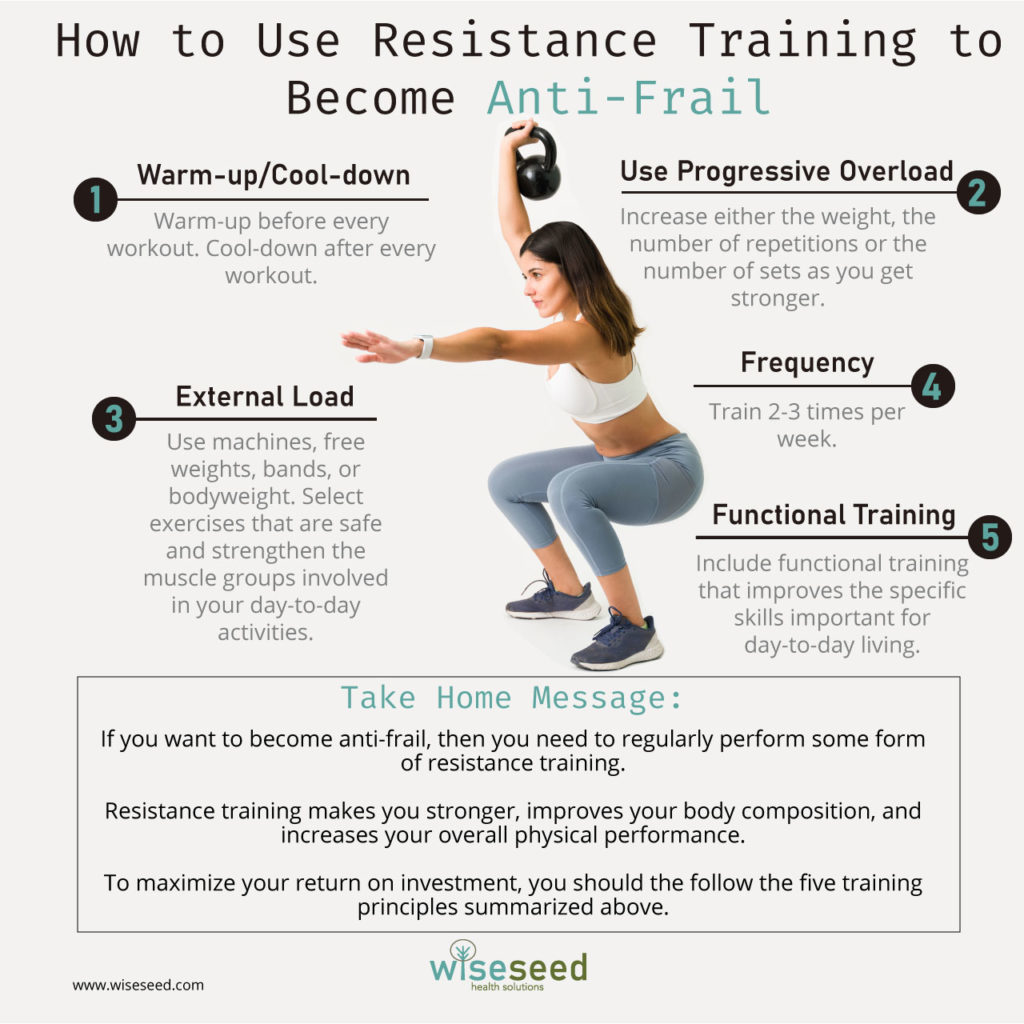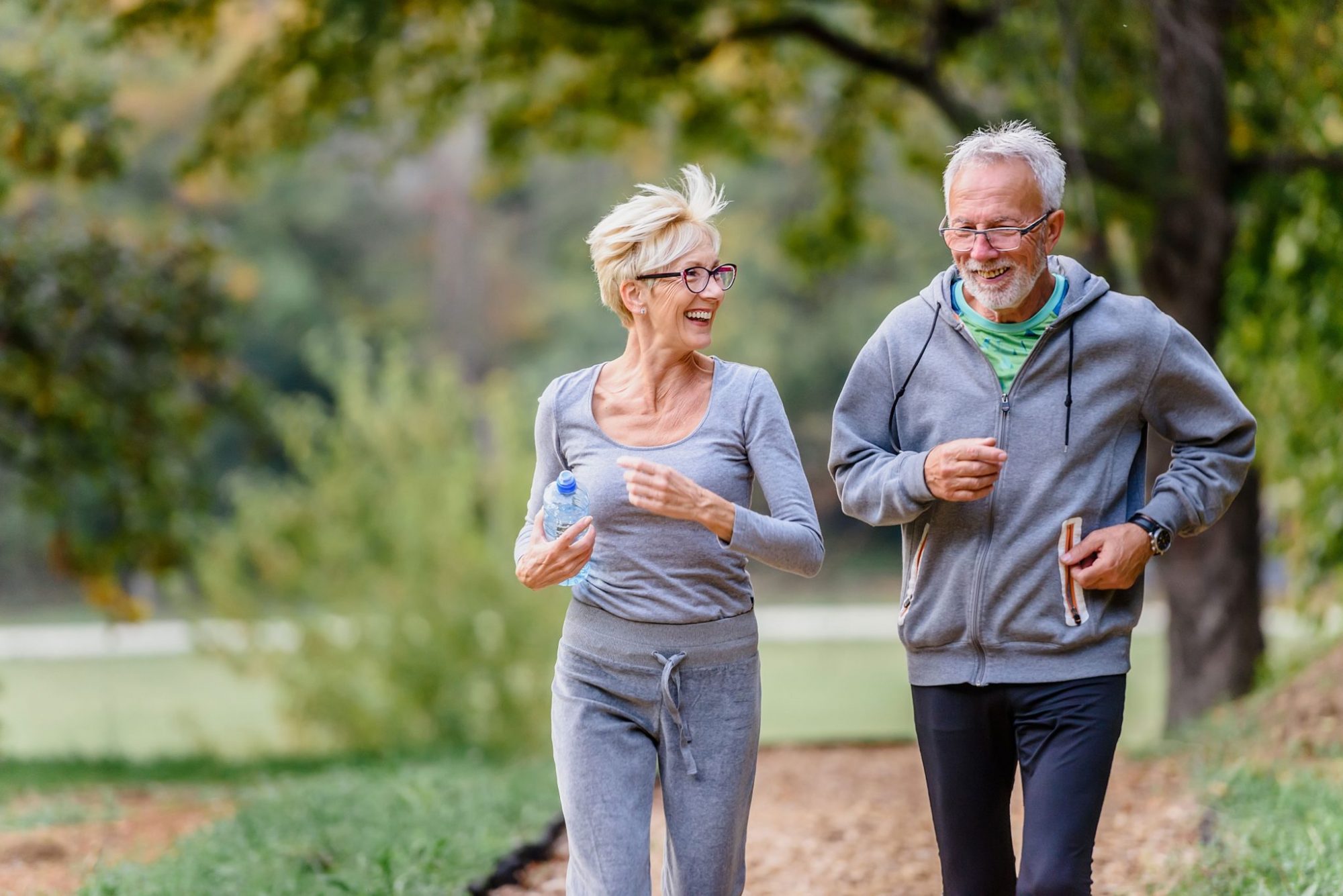How to Use Resistance Training to Become Anti-Frail

“Old age should burn and rave at close of day”
Dylan Thomas
If you succumb to frailty, you are at a high risk of disability, hospitalization, and premature death (1). The question is, can you avoid age-related frailty? Damn right you can!
In my last article, I revealed that exercise greatly reduces your chance of suffering from age-related frailty. But the question remains, what types of exercise should you use? In this article, I argue that strength training should become a foundational part of your anti-frail lifestyle.
Muscle Wasting and Age
The progressive loss of muscle mass is an unfortunate hallmark of aging (2). Without intervention, you will begin to lose muscle at a rate of up to 2% every year after the age of 50 (3-5)!
The medical term for age-related muscle loss is sarcopenia. Sarco is Latin for flesh, while penia is ancient Greek for deficiency or poverty. Thus, sarcopenia simply means a deficiency or poverty of flesh. Sarcopenic patients display the following symptoms: low muscle strength, poor muscle quantity or quality, and a reduced physical performance (6).
Unfortunately, sarcopenia is highly prevalent within our elderly population, with 30% of people over the age of 65 years and 50% of the population over the age of 80 years suffering from this disease (6-8).
The Heavy Price of Sarcopenia
Sarcopenia significantly compromises your strength, your endurance, and your overall physical performance (9-11). In terms of your health and longevity, a diagnosis of sarcopenia is nothing but bad news. Sarcopenia increases your risk of falling and fracturing a bone (12, 13), experiencing cardiac and respiratory disease (14, 15), and suffering cognitive impairment (16). Worst of all, sarcopenia increases your risk of all-cause mortality within a variety of settings (for example see (17-21)). These factors make sarcopenia one of the major contributors to age-related frailty.
In a nutshell, sarcopenia reduces your quality of life, makes you vulnerable to disability, and increases your chance of dying young (7).
What the Researchers Did
Historically, sarcopenia was accepted as an inevitable consequence of getting old. Fortunately, resistance training is emerging as a safe and effective intervention for treating and preventing sarcopenia (22). To confirm that strength training can be used to prevent and treat sarcopenia, Talar et al recently analysed 25 independent clinical trials that tested resistance training in pre-sarcopenic and sarcopenic old adults (23).
Before we go on, it’s important to understand exactly what is meant by resistance training. The Authors define resistance training as ‘a strength training exercise with the use of progressive overload in which the muscles create the force against external load’ (23). Note that external load can be created using a variety of tools. For example, different clinical trials used free weights, machines, body weight and bands to provide external load. Progressive overload simply means that as you get stronger, you either increase the number of repetitions, increase the number of sets, or increase the weight lifted.
What the Researchers Found
Happily, the Authors assessed a wide variety of functional outcomes in their study, providing a broad overview of the benefits of resistance training for older adults.
Strength
Strength was assessed using handgrip strength, which provides a reasonable estimate of overall body strength, and lower body strength. The Authors found that resistance training provides moderate improvement to handgrip strength and large improvements to lower body strength in sarcopenic older adults (23).
The same positive trends were observed in pre-sarcopenic adults, but this did not reach statistical significance due to the small number of studies (23).
Conclusion: Resistance training increases the strength of older adults suffering sarcopenia. Further, resistance training is likely to prevent the onset of sarcopenia.
Functional Performance
What I love most about this study is that the researchers assessed a wide range of important physical attributes. These were agility and balance, walking speed, and the ability to perform everyday tasks that require strength. Strikingly, resistance training has a positive effect on agility, balance, walking speed, and functional strength in older adults suffering from sarcopenia (23).
In pre-sarcopenic adults, resistance training also had a positive effect on functional strength and walking speed (23). Agility and balance both showed a positive trend in response to resistance training, however this did not reach statistical significance as the sample size was too small.
Conclusion: Resistance training increases the functional performance of sarcopenic and pre-sarcopenic older adults.
Body Composition
More good news for older adults. Resistance training simultaneously reduces fat (small effect) and increases muscle mass (small effect). Hooray! The same trends were observed in pre-sarcopenic older adults, but once again this did not reach statistical significance due to the small number of studies in this population.
Conclusion: Resistance training both reduces fat and increases muscle mass in sarcopenic older adults. Resistance training likely does the same in pre-sarcopenic older adults.
How to Train for Optimal Results
Regrettably, the Authors of the article didn’t analyze which training methods produced the best results. Therefore, I selected the articles that showed the greatest improvements across all physical domains and then assessed how these researchers trained their subjects. This simple analysis yielded the following five principles.
The Five Principles of Resistance Training for Older Adults
- Warming up and cooling down are essential.
- Resistance training must be progressive. This means that you increase either the weight, the number of repetitions or the number of sets as you get stronger.
- The form of resistance is irrelevant. Machines, free weights, bands, or bodyweight all work. The keys to exercise selection are safety followed by choosing exercises that strengthen the muscle groups involved in your day-to-day activities.
- You should strength train 2-3 times per week.
- For optimal results, you should also include functional training that improves the specific skills important for day-to-day living. For example, you could train balance, mobility, and walking/running.
Take Home Message
If you want to become anti-frail, then you need to regularly perform some form of resistance training. This is because resistance training makes you stronger, improves your body composition, and increases your overall physical performance. However, to maximize your return on investment, you should the follow the five training principles summarized above. These are particularly relevant if you are over sixty years of age.
Please click on the link below for your free PDF.

References and Further Reading
1. Q.-L. Xue, The frailty syndrome: definition and natural history. Clinics in Geriatric Medicine 27, 1 (2011).
2. W. J. Evans, What is sarcopenia? J Gerontol A Biol Sci Med Sci 50 Spec No, 5-8 (1995).
3. T. W. Buford et al., Models of accelerated sarcopenia: critical pieces for solving the puzzle of age-related muscle atrophy. Ageing Res Rev 9, 369-383 (2010).
4. K. S. Nair, Aging muscle. Am J Clin Nutr 81, 953-963 (2005).
5. W. K. Mitchell et al., Sarcopenia, dynapenia, and the impact of advancing age on human skeletal muscle size and strength; a quantitative review. Front Physiol 3, 260 (2012).
6. A. J. Cruz-Jentoft et al., Sarcopenia: revised European consensus on definition and diagnosis. Age Ageing 48, 16-31 (2019).
7. A. J. Cruz-Jentoft, F. Landi, E. Topinkova, J. P. Michel, Understanding sarcopenia as a geriatric syndrome. Curr Opin Clin Nutr Metab Care 13, 1-7 (2010).
8. I. P. Levinger, S. Duque, G., Sarcopenia and Osteoporotic Fractures. Clinic Rev Bone Miner Metab 14, 38-44 (2016).
9. P. Cherin, E. Voronska, N. Fraoucene, C. de Jaeger, Prevalence of sarcopenia among healthy ambulatory subjects: the sarcopenia begins from 45 years. Aging Clin Exp Res 26, 137-146 (2014).
10. M. L. Dirks et al., Skeletal muscle disuse atrophy is not attenuated by dietary protein supplementation in healthy older men. J Nutr 144, 1196-1203 (2014).
11. C. Suetta et al., Aging affects the transcriptional regulation of human skeletal muscle disuse atrophy. PLoS One 7, e51238 (2012).
12. H. A. Bischoff-Ferrari et al., Comparative performance of current definitions of sarcopenia against the prospective incidence of falls among community-dwelling seniors age 65 and older. Osteoporos Int 26, 2793-2802 (2015).
13. L. A. Schaap, N. M. van Schoor, P. Lips, M. Visser, Associations of Sarcopenia Definitions, and Their Components, With the Incidence of Recurrent Falling and Fractures: The Longitudinal Aging Study Amsterdam. J Gerontol A Biol Sci Med Sci 73, 1199-1204 (2018).
14. G. Bahat, B. Ilhan, Sarcopenia and the cardiometabolic syndrome: a narrative review. European Geriatric Medicine 7, 220-223 (2016).
15. A. E. Bone, N. Hepgul, S. Kon, M. Maddocks, Sarcopenia and frailty in chronic respiratory disease: Lessons from gerontology. Chronic Respiratory Disease 14, 85-99 (2017).
16. K.-V. Chang, T.-H. Hsu, W.-T. Wu, K.-C. Huang, D.-S. Han, Association between sarcopenia and cognitive impairment: a systematic review and meta-analysis. Journal of the American Medical Directors Association 17, 1164. e1167-1164. e1115 (2016).
17. S. L. De Buyser et al., Validation of the FNIH sarcopenia criteria and SOF frailty index as predictors of long-term mortality in ambulatory older men. Age and Ageing 45, 602-608 (2016).
18. P. Liu et al., Sarcopenia as a predictor of all-cause mortality among community-dwelling older people: A systematic review and meta-analysis. Maturitas 103, 16-22 (2017).
19. G. A. Kelley, K. S. Kelley, Is sarcopenia associated with an increased risk of all-cause mortality and functional disability? Exp Gerontol 96, 100-103 (2017).
20. X. Zhang et al., Sarcopenia as a predictor of all-cause mortality among older nursing home residents: a systematic review and meta-analysis. BMJ Open 8, e021252 (2018).
21. W. Xia, A. W. H. Barazanchi, W. S. MacFater, A. G. Hill, The impact of computed tomography-assessed sarcopenia on outcomes for trauma patients – a systematic review and meta-analysis. Injury 50, 1565-1576 (2019).
22. B. C. Clark, L. A. Clark, T. D. Law, Resistance exercise to prevent and manage sarcopenia and dynapenia. Annual Review of Gerontology and Geriatrics 36, 205-228 (2016).
23. K. Talar et al., Benefits of Resistance Training in Early and Late Stages of Frailty and Sarcopenia: A Systematic Review and Meta-Analysis of Randomized Controlled Studies. Journal of Clinical Medicine 10, 1630 (2021).
Acknowledgements
Images provided by BartekSzewczyk and Antonio_Diaz
Disclaimer
The material displayed on this website is provided without any guarantees, conditions or warranties as to its accuracy.
Information written and expressed on this website is for education purposes and interest only. It is not intended to replace advice from your medical or healthcare professional.
You are encouraged to make your own health care choices based on your own research and in conjunction with your qualified practitioner.
The information provided on this website is not intended to provide a diagnosis, treatment or cure for any diseases. You should seek medical attention before undertaking any diet, exercise, other health program or other procedure described on this website.
To the fullest extent permitted by law we hereby expressly exclude all warranties and other terms which might otherwise be implied by statute, common law or the law of equity and must not be liable for any damages whatsoever, including but without limitation to any direct, indirect, special, consequential, punitive or incidental damages, or damages for loss of use, profits, data or other intangibles, damage to goodwill or reputation, injury or death, or the cost of procurement of substitute goods and services, arising out of or related to the use, inability to use, performance or failures of this website or any linked sites and any materials or information posted on those sites, irrespective of whether such damages were foreseeable or arise in contract, tort, equity, restitution, by statute, at common law or otherwise.

Ten Minutes is All You Need
Research has shown that ten minutes of moderate-to-vigorous exercise performed each day is enough to significantly reduce your risk of early death.

Become More Resilient through Flexible Self-Regulation
Flexible self-regulation is an evidence-based strategy that can help you stay healthy after potentially traumatic experiences.




